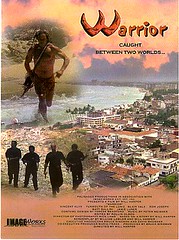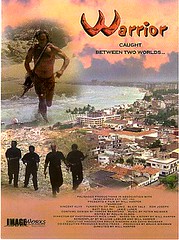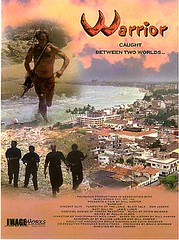action adventure fantasy feature film "Warrior"
http://imdb.com/title/tt0320751
http://www.warriorthefilm.blogspot.com
Monday, July 2, 2001
Multiethnic Movies Ringing True With Youths
Hollywood: Colorblind audiences flock to films that capture a culture.
By ROBERT W. WELKOS, RICHARD NATALE, Special to The Times
Hollywood was stunned late last month when the youth-oriented action film "The Fast and the Furious" streaked past the competition to become the No. 1 movie, with $40.1 million in ticket sales.
With its relatively unknown cast of whites, Latinos, Asians and African Americans, heavy doses of high-speed chases and a driving hip-hop soundtrack, the movie defied expectations and sent studio executives scrambling to understand why this film about the illegal street-racing subculture had become a summer hit.
But the teen-oriented movie's success isn't so surprising when one glimpses the youthful crowds flocking to theaters such as the Cineplex Odeon at Universal CityWalk. With their ultra-baggy cargo shorts, doo-rags wrapped around their heads, and bodies festooned with tattoos and piercings, the look of these young moviegoers mirrors the multiethnic melange of actors on the screen.
Esteban Mejia, 20, of east Hollywood, who wears long shorts and a diamond stud and hoop "cartilage pierce" in his left ear, said the racial diversity of the movie has a distinct appeal that most mainstream movies don't have. He wouldn't go to primarily white teen movies like "She's All That," Mejia said, because he doesn't relate to white kids trying to act "hard" like their Latino and black peers.
"I don't want to see 'Clueless,' " he said, recalling the 1995 Alicia Silverstone teen comedy set in Beverly Hills. "Did I live a 'Clueless' life? No. Do I live a 'Clueless' life? No. If there's something that I've been through, then, yeah, I'll go."
Hollywood likes to pride itself on being ahead of the cultural curve, but with last summer's sassy white-versus-black cheerleading comedy "Bring It On" grossing $68.4 million domestically and this winter's "Save the Last Dance," with its once-taboo interracial dating, raking in more than $90 million in North America alone, the studios have only begun to catch up with the colorblind nature of today's MTV generation.
Rob Cohen, who directed "The Fast and the Furious," said the film not only reflects today's "multiculti" youth culture without purposely drawing attention to it, but depicts what is really going on.
When the movie opened, it drew a cross-section of races. Cohen said surveys taken at theaters where "The Fast and the Furious" played showed that 50% of moviegoers were white, 24% were Hispanic, 10% were black and 11% were Asian.
"I look at this and go, 'This is exactly what I'm talking about,' " Cohen said. "If that had been 80% ethnic and 20% white, that is not what we wanted. We wanted to affect the whole culture. This picture is not an 'ethnic' movie, it's an everybody movie."
Attracting a young audience across the country--a mainstay of big summer popcorn hits--"The Fast and the Furious" has grossed an estimated $78 million in less than two weeks and is on track to make well over $100 million.
Touchstone Pictures' romantic drama "crazy/beautiful," which opened Friday, deals with a Latino boy from a working-class East L.A. neighborhood who falls for a troubled girl from affluent Pacific Palisades. Mary Jane and Harry J. Ufland, who along with Rachel Pfeffer produced "crazy/beautiful," say that today's youth increasingly see the world as colorblind.
"I think we live in a multiracial world, and we want to make movies everyone identifies with," Mary Jane Ufland said. "When we started off . . . we wanted to tell a good story reflective of teenagers across the country, but also specifically about Los Angeles. We live in Santa Monica next to the Palisades, and we're very aware of Pali High and busing kids in from all over L.A."
Marc Abraham, one of the producers of "Bring It On," noted: "There is a much more interracial aspect [in today's culture] than the way this country used to be. Any movie that reflects that--and it doesn't mean they'll all be hits like 'The Fast and the Furious'--will ring true with the audience."
Over the years, studios have produced a steady diet of "niche" films targeting demographic markets such as African Americans. They know that black-themed movies can readily draw huge crowds from African American communities--"Waiting to Exhale," for example--but these films rarely capture the "crossover" white audience that is crucial in turning a moderately successful film into a blockbuster.
John Singleton's "Boyz N the Hood" was able to cross over, but few movies do. Where they do work is in broad comedies where there is an identifiable African American star, such as Eddie Murphy, Martin Lawrence or Chris Tucker.
Studios realize they can attract a crossover audience if a film realistically portrays the ethnic mix of society, so long as it doesn't appear cynical or calculated.
"[The movie business is] certainly catching up with what's happening in society," said Thomas Carter, who directed "Save the Last Dance." ". . . Youth culture has been shifting a long time, but because of the generation that runs the studios, there's been a certain attitude, and it has taken them a while to catch up. Places like MTV are right on the edge and totally involved in the change. In filmmaking, we lag behind."
If Hollywood made a movie like "Save the Last Dance" 10 years ago, studios would have emphasized the interracial love story. This movie, however, was sold more like "Flashdance" and did not sensationalize the love affair. And Carter noted that in "The Fast and the Furious," little attention was paid to race.
This shift is starkly reflected in recent U.S. census statistics, which show that nearly one in three Americans is a member of a minority group and that 15.4 million people--most of them Latino--said they were "some other race" than white, black, Asian, Pacific Islander or American Indian. The census also found that 6.8 million people identified themselves as belonging to two or more races.
"I think the segregated groupings are breaking down in today's America, and I think today's movie audience is a complex mix," said Marc Shmuger, vice chairman of Universal Pictures, which released "The Fast and the Furious."
But Shmuger warned that if the movie industry starts making multiethnic movies "in a calculating and cynical fashion," the audience will sense that and stay away.
The Motion Picture Assn. of America said that in 1998, 71% of all movie admissions were white, 11% black and 11% Hispanic; all others accounted for 7%. In 1999, the fastest-growing group was Hispanic, which saw its moviegoer percentage climb to 15%.
Just as "The Fast and the Furious" shows young people of all races gathered in large groups unmindful of their racial differences and not hung up on sex, Gary Scott Thompson, one of the film's writers, said today's young movie audiences also are that way.
"It used to be a boy and a girl would go on a date," he said. "Now what's happening is groups of kids who are friends--multiracial boys and girls--all move in date packs together. It's like a date, but they don't consider it dating. They just consider themselves friends. Some of them might neck, some of them might not. None of them think anything much about it. They are much more open when talking about sex, teasing about it, too. They've broken down the cultural barriers."
In Hollywood, where studio executives dine at trendy watering holes and hobnob with people of like lifestyles and social strata, it isn't any wonder that the film business has been slow to pick up on this trend, observers said.
"I think the conservative nature of the movie business comes from the fact that movies cost a considerable amount now," said producer Kevin Misher, former head of production at Universal. "The first instinct is to find the movie star to protect your investment.
"What's begun to evolve, however, is the question of who is a movie star," Misher said. "This youth audience may be embracing a whole new breed of movie star. They are multiethnic and don't necessarily just come from music."
Rob Friedman, vice chairman of Paramount Pictures Motion Picture Group, said the studio began noticing the colorblind nature of young audiences with its 1999 high school pigskin drama "Varsity Blues."
"It's really about their peers, regardless of race, and to a certain extent, gender as well," Friedman said. ". . . When it came to 'Save the Last Dance,' it became more and more apparent young people don't care [whether the relationship is interracial]. The music is great, the story is great."
Director Carter said that since the birth of jazz, music has been colorblind. Destiny's Child and TLC, Janet Jackson, are bought by everyone, he noted. The video for "Moulin Rouge" for example, features Pink, Lil' Kim, Mya, Christina Aguilera. "And you're not thinking who's white, black or Latino. You're thinking those are some hot ladies," he said.
"Ultimately, that's where we want to get," Carter said. "These groups don't lead with race. They lead with a common interest. Kids who like science and computers get together. Kids interested in sports get together. Those were the things that separated them, not race. We're just playing catch-up with that."
For teens like Alvaro Alvarez of Los Angeles, it doesn't matter that "The Fast and the Furious" has no big stars or makes a statement about race. It's "the cars, the action" that draw him.
"I'm just going for the cars," said the 18-year-old. "It doesn't matter who the actors are. It's something that's in style right now."
* * *
Times staff writer Emmanuelle Soichet contributed to this story.
Copyright 2001 Los Angeles Times
see http://imdb.com/title/tt0320751 ... "the action adventure fantasy feature film "Warrior" ... about the son of a divine force ... is a story of a young man's quest to find his true identity set against the twin backdrops of Native American folklore and the treacherous Mexican drug trade and a portrayal of the classic confrontation between "good and evil" ... filmed in the exotic jungles of Costa Azul and the urban grit of Puerto Vallarta in the State of Jalisco, Mexico .. with action, adventure, romance, comedy, a multi-ethnic cast, a major studio movie music score and spectacular cinematography..."






